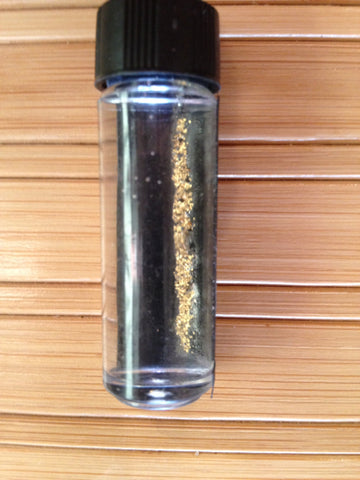Recreational Gold Prospecting and Production
How To Make Recreational Gold Prospecting Lucrative and Efficient
I like to define the term “Recreational Gold Prospecting” as going out with family and friends, washing rocks on a pristine river, and finding a bit of gold. Imagine this, you’re out with the family enjoying the day on the river with your Gold Rush Nugget Bucket, and you find a spot that has the potential for an large amount of placer gold or perhaps larger flakes that you never have found before. There may be a more concentrated amount of fine gold there as well, which continues for several yards up the river about six inches deep in the water. What are you going to do, buy a large and expensive High Banker or Sluice Box, then come back lugging in heavy tools?

Flour gold in a vial.
If you want an easier solution that’s lightweight, affordable and fun, consider the Gold Rush Nugget Bucket. I'm not talking about competing with the big equipment in Alaska or the Yukon, we are just moving from a “recreational prospecting model” to a “recreational production model.” Hypothetically, our own placer gold pay streak is in an area of six inches deep by two feet wide, and stretches for four yards. We discovered this by playing on the bank with the kids and testing several spots on the inside bend. A rough calculation will tell you that you will probably need to move and process roughly 1/2 of a cubic yard of gravel and cobble. Lets break that down a bit further: that is about 20, 5-gallon buckets worth of unclassified material. After lifting that much material, I want to know one thing: how is your back feeling?
In order to be as efficient as possible, we want to move lots of material reasonably fast. The Gold Rush Nugget Bucket will need a bit of help so lets introduce a couple items, starting with the “Bucket Grizzly.” The Bucket Grizzly sits on top of a 5-gallon pail and you shovel the gravel onto it. It classifies the gravel to 1/2 or 1/4 inch depending on the screen, and uses an electric 1100 GPH pump with battery. Now you can wash the gold and sand from the rocks as it goes through your Bucket Grizzly, and then supply water to the Gold Rush Nugget Bucket with minimal effort. By filling the top tray of the Gold Rush Nugget Bucket with 1/2 inch classified material, you can process it faster than trying to wash off larger cobble.

Example of a Bucket Grizzly on a 5-gallon bucket.
I have found that two people are required for maximum efficiency in production mode. One person classifies, the other runs the classified material through the Gold Rush Nugget Bucket. I have also determined that over-filling the top tray with material will actually slow the process down. Two shovels per tray is best. You will want to check the bottom tray consistently to decide when it needs to be emptied. We keep everything from the bottom tray in a separate container so we can search for “pickers” later. For every 20 of the top trays we empty the catch bowl into, we keep the rest of the concentrates and process them once we get home.

Recovering fine gold on a miller's table at home.
To ensure we don’t miss the very finest micron gold, I add a disk of “Miners Moss” to the bottom of the concentration bowl. Every hour, we pan out the catch bowl to make sure we are still on the gold and then continue with production. From one trip to the North Saskatewan River in Alberta, Canada and with 10 hours of work, we classified more than15 Gallons of river bed material, classified it to 1/4 inch through the Gold Rush Nugget Bucket, and came home with only three 5-gallon buckets of concentrates. A quick test showed 300 specks of ( -100 ) gold in only a tablespoonful of the concentrates, all thanks to the Gold Rush Nugget Bucket, which really catches the fine stuff. Next post I will be discussing my “Gold Sampling Procedure.”


Comments
6 Comments